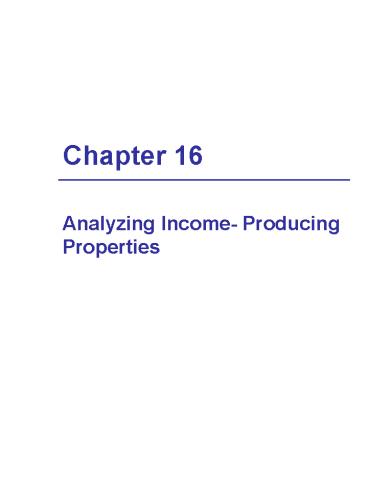Analyzing Income Producing Properties
1 / 21
Title:
Analyzing Income Producing Properties
Description:
Liquidity risk: Discounts on quick sales. ... The Discounted Cash Flow Model ... Discounted Cash Flow Model. T. NPV=S ATCFt ATERT - Initial. t=1 (1 i)t (1 ... – PowerPoint PPT presentation
Number of Views:53
Avg rating:3.0/5.0
Title: Analyzing Income Producing Properties
1
Chapter 16
- Analyzing Income- Producing Properties
2
Why forecasting?
- Forecast not guess
- Maximize investment dollars
- Locate profits in projects that others overlook
3
Advantages of Real Estate Investment
- Cash Flow from Operations (After Tax Cash Flow
ATCF) - Appreciation (After Tax Equity Reversion ATER)
- Portfolio Diversification
- Financial Leverage
- Tax Benefits
4
Cash Flow
- After Tax Cash Flow (ATCF)
- Income
- Revenue minus Costs
- Revenue Includes
- Rent
- Extras
- e.g. laundry services, covered parking
- Expense Escalators
- In commercial real estate
- Tenant contracted to pay increase in costs (e.g.
utilities) - Costs Include
- Debt, insurance, taxes, maintenance, etc.
5
Appreciation
- After Tax Equity Reversion (ATER)
- Equity reversion return of funds originally
invested in the property plus any increase in
property value.
6
Portfolio Diversification
- Real Estate investments can diversify your entire
portfolio of investments - - Stocks, bonds, etc.
- Spread investment risk over different investment
vehicles. - Some like Real Estate because it is tangible and
long-term.
7
Financial Leverage
- Other peoples money
- - Down payment and borrow the remainder
- Magnifies investment returns
- A. Purchase a 100,000 office with 100 equity or
- B. Use the 100,000 to put down 10 on a
1,000,000 office building and borrow 900,000. - assume incomecosts
- After 1 year, both properties increase 10 and
are sold. - 110,000-100,000 10,000 profit / 100,000
investment 10 return - 1,100,000 - 1,000,000 100,000 profit /
100,000 investment 100 return
8
Tax Benefits
- Write losses against other income
9
Disadvantages of Real Estate Investment
- large capital requirements
- risk
- Financial risk (Large Capital requirements)
- Liquidity risk Discounts on quick sales.
- Purchasing power risk Tie money up for large
periods of time. - Business risk (Changing market conditions) R.E.
requires specialized knowledge of markets and
transactions affecting specific sectors.
10
The Wealth Maximization Objective
- investment can be defined as present sacrifice in
anticipation of future benefit - investment decision making involves comparison of
the expected future benefits with the costs of
the investment - investors ultimate goal is to maximize their
wealth by choosing investments that are worth
more than they cost - the NPV decision rule employs the wealth
maximization concept - If faced with two competing projects, one that
offers an NPV of 1,501 and another that offers a
NPV of 703, the investor would prefer the one
with the largest NPV.
11
The Discounted Cash Flow Model
- To apply the NPV rule in practice, real estate
investors may use the following discounted cash
flow model.
12
After Tax Cash Flow (ATCF)
- Potential Gross Income
- -Vacancy Collection Loss
- -Operating Expenses
- -Debt Service
- -Taxes
- After Tax Cash Flow (ATCF)
13
After Tax Equity Reversion (ATER)
- Gross Sale Price
- -Selling Expenses
- -Loan Payoff
- -Taxes
- After Tax Equity Reversion (ATER)
14
Discounted Cash Flow Model
- T
- NPVS ATCFt ATERT - Initial
- t1 (1i)t (1i)T Equity
15
Highlights of Property Search (from p.358-359)
- Individual Investor
- Limited Funds
- Familiar Neighborhood
- Rental Expense Knowledge
- Talk to lenders
- Estimate future increases in expenses and income
16
After Tax Cash Flow (ATCF)
- Potential Gross Income (PGI)
- -Vacancy Credit Losses (VCL)
- Effective Gross Income (EGI)
- -Operating Expenses (OE)
- Net Operating Income (NOI)
- -Annual Debt Service (ADS)
- Before Tax Cash Flow (BTCF)
- -Taxes
- After Tax Cash Flow (ATCF)
17
Calculating Taxes for ATCF
- Net Operating Income (NOI)
- -Interest Expense (INT)
- -Depreciation Deduction (DEP)
- Taxable Income (TI)
- x Marginal Tax Rate (MTR)
- Taxes from Operations (Taxes)
18
After Tax Equity Reversion (ATER)
- Sale Price
- -Sale Expenses
- Net Sale Price
- -Loan Balance
- Before Tax Equity Reversion
- -Taxes
- After Tax Equity Reversion
19
Calculating Taxes for ATER
- Net Sale Price
- -Purchase Price
- Accumulated Depreciation
- Taxable Gain
- x Marginal Tax Rate
- Taxes
20
Example of the DCF Model
- Consider a four-unit apartment complex that is
offered for sale at 255,000. - The units are expected to rent for 725 per month
in the first year (increasing at 5 per year)
with an annual vacancy rate of 4. - The property is expected to have operating
expenses of 9,900 in the first year (increases
at 3 per year). - A loan is available at 70 of the purchase price
for 9 interest with monthly payments over 25
years. - The investor believes property value will
increase at the annual rate of 5 per year. - The investor faces a tax rate of 28.
- The investor expects a five year holding period.
- Is this a good deal based on the NPV rule at a
required rate of return of 16? - See cash flow calculations in Tables 16.3 and 16.4
21
End Chapter 16
- Questions?































